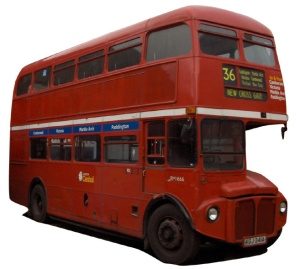 Traffic is a problem for drivers and bus riders alike. When traffic gets bad, it gets even worse for buses downtown. Here is why:
Traffic is a problem for drivers and bus riders alike. When traffic gets bad, it gets even worse for buses downtown. Here is why:
Transit agencies, in their quest to put more capacity on popular routes, have added long “bendy” buses to their fleets. The problem is that these buses require twice the available space before an intersection to be able to move from one block to another. They also have more difficulty changing lanes and negotiating corners than standard buses. During periods of heavy traffic this often results in “bendy” buses being unable to move to the next block for more than one light cycle, backing up traffic behind them and delaying other, shorter buses that might have fit into the smaller space in front of them. The answer?
 Seattle and other communities should take a second look at double-decker buses for popular routes that traverse the city center or look to banish “bendy” buses from downtown routes altogether. Double-decker buses are only slightly taller than most standard buses, have a smaller footprint than bendy buses, and give riders a nice view of the city.
Seattle and other communities should take a second look at double-decker buses for popular routes that traverse the city center or look to banish “bendy” buses from downtown routes altogether. Double-decker buses are only slightly taller than most standard buses, have a smaller footprint than bendy buses, and give riders a nice view of the city.
Now I must say that I did one time see a double-decker public bus cruising through downtown Seattle the other day. It was a route 417 on its way to Mukilteo and it effortlessly cruised through a yellow light to get the last spot in the bus zone (one a bendy bus wouldn’t have fit in).
I don’t know if the regional transit bureau serving areas north of Seattle has more than one double-decker bus in their fleet or whether this is a test bus for a future purchase, but it sure looked better cruising through downtown Seattle than a bendy bus bouncing up and down. There is nothing quite like the view from the upper-deck of a double-decker bus as you cruise through a city. I hope this is the sign of more to come. Bendy buses may be a newer concept, but double-decker buses are a better one. Oh yeah, and keep the WiFi coming, people love their WiFi on the buses. 🙂
![]() Sign up here to get Human-Centered Change & Innovation Weekly delivered to your inbox every week.
Sign up here to get Human-Centered Change & Innovation Weekly delivered to your inbox every week.
